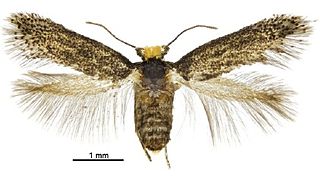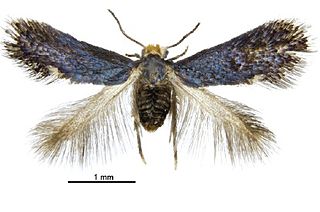
Acalyptris pistaciae is a moth of the family Nepticulidae. It is found in the eastern Mediterranean region, where it is widespread in Greece, Cyprus and Turkey. It is probably also present in Syria and Lebanon. Mines collected in Israel in 1931 and identified as Simplimorpha promissa may also belong to be this species.
Stigmella gimmonella is a moth of the family Nepticulidae. It is only known from Hokkaido in Japan.
Pectinivalva caenodora is a moth of the family Nepticulidae. It is found along the south-eastern coast of New South Wales.
Pectinivalva commoni is a moth of the family Nepticulidae. It is found along the south-western coast of Western Australia.
Pectinivalva endocapna is a moth of the family Nepticulidae. It is found along the south-western coast of Western Australia.
Pectinivalva melanotis is a moth of the family Nepticulidae. It is found along the south-eastern coast of New South Wales.
Pectinivalva libera is a moth of the family Nepticulidae. It is found along the southeastern coast of New South Wales.
Pectinivalva primigena is a moth of the family Nepticulidae. It is found along the south-eastern coast of New South Wales, Australia.
Pectinivalva trepida is a moth of the family Nepticulidae. It is found along the south-eastern coast of Victoria.
Pectinivalva warburtonensis is a moth of the family Nepticulidae. It is found on the Warburton Ranges in Western Australia.

Trifurcula subnitidella is a moth of the family Nepticulidae. It is widespread in Europe southward to the northern border of the Sahara in Tunisia and eastward to the Crimea and Asia minor.

Parafomoria pseudocistivora is a moth of the family Nepticulidae. It is probably found in the whole Mediterranean region.
Stigmella montanotropica is a moth of the family Nepticulidae. It is found in tropical montane forest on the western slopes on the Andes in Ecuador.

Pectinivalva mystaconota is a moth of the family Nepticulidae. It is known from scattered localities in eastern Australia from Wellington, New South Wales south to Mount Nelson, Hobart, Tasmania.

Pectinivalva brevipalpa is a moth of the family Nepticulidae. It is found in New South Wales.

Pectinivalva minotaurus is a moth of the family Nepticulidae. It is found in southern Queensland.

Pectinivalva scotodes is a moth of the family Nepticulidae. It is found in New South Wales and southern Queensland.

Pectinivalva acmenae is a moth of the family Nepticulidae. It is found in New South Wales.

Pectinivalva tribulatrix is a moth of the family Nepticulidae. It is found in northern Queensland.

Pectinivalva xenadelpha is a moth of the family Nepticulidae. It is found in Borneo, east Kalimantan.














